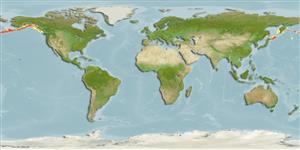Environment: milieu / climate zone / depth range / distribution range
Ecology
Marine; bathydemersal; depth range 128 - 3356 m (Ref. 58496). Deep-water
North Pacific: Okhotsk Sea, off northern Kuril Islands and southeastern Kamchatka, southern Bering Sea, Gulf of Alaska (Ref. 51661). Reported to range south to British Columbia, Canada (Ref. 11366).
Size / Weight / Age
Maturity: Lm ? range ? - ? cm
Max length : 10.0 cm TL male/unsexed; (Ref. 41039)
Minimum depth reported at 128 m (Ref. 50550).
Life cycle and mating behavior
Maturities | Reproduction | Spawnings | Egg(s) | Fecundities | Larvae
Quast, J.C. and E.L. Hall, 1972. List of fishes of Alaska and adjacent waters with a guide to some of their literature. U.S. Dep. Commer., NOAA Tech. Rep. NMFS SSRF-658, 47 p. (Ref. 6876)
IUCN Red List Status (Ref. 130435)
Threat to humans
Harmless
Human uses
Tools
Special reports
Download XML
Internet sources
Estimates based on models
Preferred temperature (Ref.
123201): 2.3 - 3.7, mean 2.8 °C (based on 43 cells).
Phylogenetic diversity index (Ref.
82804): PD
50 = 0.5000 [Uniqueness, from 0.5 = low to 2.0 = high].
Bayesian length-weight: a=0.00525 (0.00237 - 0.01161), b=3.15 (2.96 - 3.34), in cm total length, based on LWR estimates for this (Sub)family-body shape (Ref.
93245).
Trophic level (Ref.
69278): 3.4 ±0.5 se; based on size and trophs of closest relatives
Resilience (Ref.
120179): High, minimum population doubling time less than 15 months (Preliminary K or Fecundity.).
Fishing Vulnerability (Ref.
59153): Low vulnerability (10 of 100).
